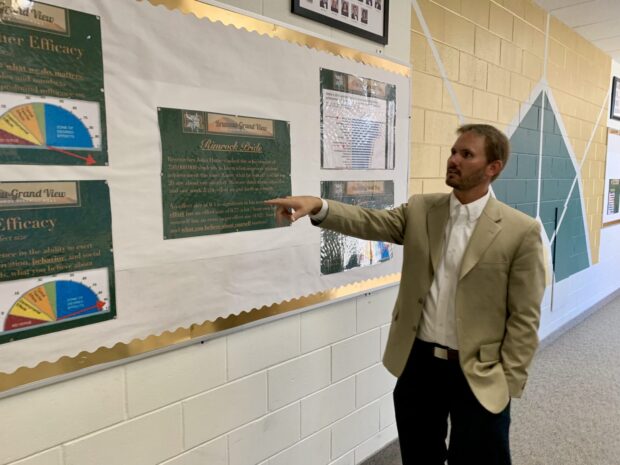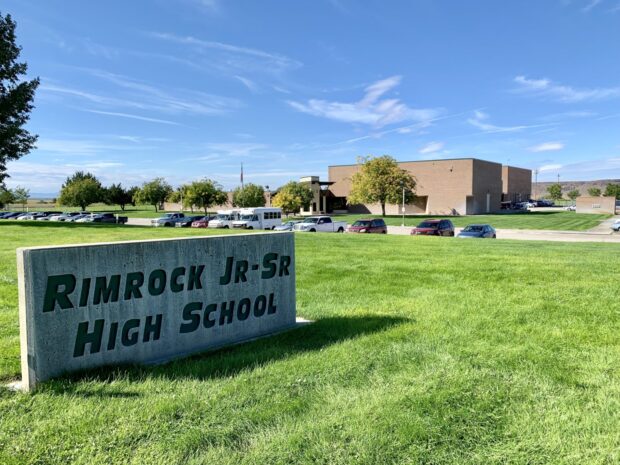BRUNEAU — Superintendent Ryan Cantrell has a new rule.
No more “yeah, buts.” As in no more excuses.
No more responding to hard questions about missing goals with an answer that begins, “yeah, but what about this?”
No more rationalizing low student achievement with, “yeah, but we’re a remote school,” “yeah, but we don’t have the same opportunities as larger schools” and certainly no more, “yeah, but we don’t have the money to do that.”
“We have to 100 percent own our student data and that’s one thing we’ve been lacking in the past, owning that data,” Cantrell said. “Schools, ourselves included, are quick to give the ‘yeah, buts.’”
It’s all part of a sustained, districtwide effort to reinvent the culture in the Bruneau-Grand View School District.
Just over a year ago, the State Department of Education identified two of the district’s three schools — Bruneau Elementary School and Rimrock Junior-Senior High — on the list of the state’s 29 lowest performing schools.
“The ‘a-ha moment’ came when we had to recognize where we were and that we weren’t very happy with where we were,” Cantrell said.
Now, the district posts assessment results in the hallways at school. And the district’s strategic plan hangs framed in Cantrell’s office.
And, little by little, Bruneau-Grand View’s reinvention effort is paying dividends. For the spring of 2019, Idaho Reading Indicator scores were up from the previous year in kindergarten, first and third grades. The improvement was most pronounced in kindergarten, where 100 percent of students met their reading benchmarks in spring 2019.
And the numbers are being celebrated across the district and the community, not because the district has reached all of its goals or put its troubles behind it, but because the new culture promotes owning the student achievement data and celebrating success and improvement.
“Once we started making goals and met them, it was like, ‘holy cow, this is working,’” Cantrell said.
Where they’ve been
Owning the data — recognizing that student achievement was low — was one of the hardest parts of changing the culture. But as difficult as it was for Cantrell and all of Bruneau-Grand View’s educators and administrators to see their schools’ names on the lowest-performing schools list, it wasn’t exactly a surprise.
For much of the past decade, the district struggled with low student achievement. Since 2012, the district has generally posted low Idaho Standards Achievement (ISAT) test results. In 2008-09, under the previous version of the IRI, just 38 percent of third-graders hit reading benchmarks.
The district couldn’t hang on to its teachers either. In 2013-14 alone, the one-year turnover rate was 38 percent.
Cantrell is in his sixth year in the district. He started as an elementary principal and has worked his way up from there.
He said the most important part of the turnaround effort is reinventing the culture, improving the climate and restoring pride in the district for students and patrons.
What’s changing
Over the past two school years, Cantrell and his leadership team have visited about 20 other schools. They’ve traveled across Idaho, Wyoming and Colorado documenting best practices they can borrow and implement in Bruneau. After each visit Cantrell files his notes into a spreadsheet, trying to pick up on what moves the needle.
- What are their financials like?
- What’s the response to intervention protocol?
- How do they run professional learning communities (PLCs)?
- How long has the core leadership team been in place?
“We got back at 12:30 in the morning from a visit to Thermopolis, Wyo., where there is a model PLC school I’ve been dying to see,” Cantrell said. “They just blew my doors off. I have never seen a better middle school ever.”
 Cantrell is fan of John Hattie’s “Visible Learning,” a research-based account of how different factors affect student achievement. He prioritizes an array of factors, from teacher efficacy to effort.
Cantrell is fan of John Hattie’s “Visible Learning,” a research-based account of how different factors affect student achievement. He prioritizes an array of factors, from teacher efficacy to effort.
After Cantrell met with the school board in July, the district made instructional leadership one of this year’s biggest areas of focus for building principals.
“It’s being in the classroom every day and having conversations about instruction with teachers every day,” said Josh Noteboom, principal of both Bruneau and Grand View elementary schools. “My attention is on instruction and outcomes.”
Over the last three years, district leaders have also become more deliberate with hiring. Now they attend recruiting fairs, searching for educators who are hungry, humble and smart.
“As we hire around those three things, our retention has gone up significantly,” Cantrell said. “Cooperative teamwork has gone up significantly. And, most important is student achievement going up.”
Now, teacher turnover is down, from 38 percent five years ago to 14 percent in 2017-18.
Where they’re going
Along with changing the culture, Bruneau-Grand View is pursuing measurable goals focused on student achievement. Perhaps the most immediate goal is to get off the list of lowest-performing schools when the new list comes out in another two years.
But that’s more of a starting point than a finish line.
 “I would love to be up toward state average and then ask ourselves, ‘What’s next? How do we get into that top 20, 30 percentile of schools?’” Cantrell said. “We visited them, we know what they look like.”
“I would love to be up toward state average and then ask ourselves, ‘What’s next? How do we get into that top 20, 30 percentile of schools?’” Cantrell said. “We visited them, we know what they look like.”
It might take years, but educators and administrators say they are committed.
“The kind of changes we want to make are not overnight changes,” Rimrock Principal Dale Burk said. “More importantly, we want them to be systemic and sustainable.”
That’s where another of Cantrell’s rules comes in — the school bus rule. Cantrell is striving to create a culture that is deeper than one administrator and will outlast a sudden leadership change. Put another way, if Cantrell is hit by the school bus Tuesday morning, he wants to make sure the culture the district is creating will remain in place.
Sustainable improvement is important to the school board.
“I’m very optimistic,” trustee Allen Merrick said. “I’ve lived in the community long enough to see what it’s like when things aren’t working smoothly, when there is turmoil and disagreement, and it’s refreshing to have things headed in the right direction.”
Brooklyn Kunsky is a mother of four who volunteers teaching art at the elementary level. She says the restoration of trust in the district and an increase in school spirit are evidence the culture is changing in positive ways.
“The difference in the change in culture over the last two to three years is a complete 180,” she said. “It’s day and night.”
Parent Mandi Boren said trust and making sure her children are ready for college when they graduate are the most important things. When she moved into the district about eight years ago, she didn’t trust the school system and voted against a bond issue proposal that ultimately failed. She then wrote a letter to the school board saying things needed to change.
“Until I can trust our administration, I can’t send you any more money,” she said, summarizing her letter. “Since then, with (Cantrell as) the new superintendent, I have complete trust. Our school board’s been shaken up quite a bit and we’ve got a new superintendent and I have complete trust to vote in favor. I know the funds are going where they need to go.”
With student achievement improving, trust being restored across the community and turnover down, Cantrell is optimistic.
“The community has been good about that, recognizing we’re on a multi-year journey together here,” Cantrell said. “They’ve been waiting for this for years to pay off, and when they see it pay off I’m happy for them that their patience has paid off.”
“We have the right ingredients, we’ve just got to keep baking the cake.”
